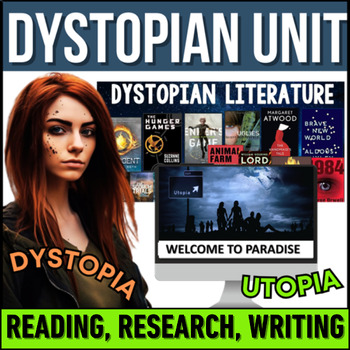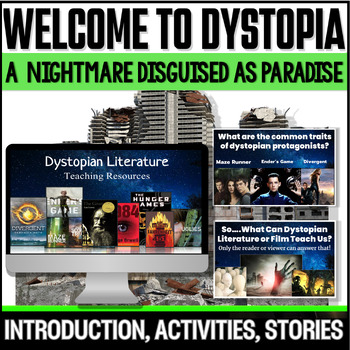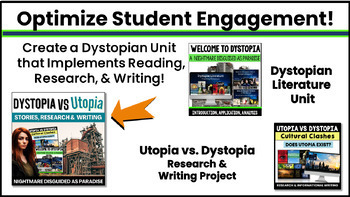Dystopian Unit Resource Bundle - Dystopia vs. Utopia - Dystopian Literature
- Zip
- Google Apps™

What educators are saying
Products in this Bundle (2)
Description
Create or supplement a Dystopian Stories Unit with this diverse, creative, high-interest teaching resource! The bundle of Dystopian literature materials include the following:
Cultural Clashes! Utopia vs. Dystopia (Research & Informational Writing)
Welcome to Dystopia: A Nightmare Disguised as Paradise (Short Story Unit)
The resources in this bundle are designed for 7th-12th grade students. Please see the following description for each resource.
Welcome to Dystopia - A Nightmare Disguised as Paradise
This resource includes the following materials:
- Table of Contents with resource links, teacher's notes, and pacing guide
- Elements of Dystopian Literature presentation with 40 slides providing a modern and engaging introduction
- Convenient links to relevant movie and book trailers
- Introduction Note-Taking Handout with Answer Key
- Image Analysis Activity 1 - Characteristics of a Dystopian Society
- Image Analysis Activity 2 - Motifs and Themes in Art and Images
- Dystopian Detector Chart with Young Adult Literature Excerpts (2 versions for differentiation) with Answer Keys
- "Harrison Bergeron" Short Story Literary Analysis (Includes a Teacher's Guide, Three Analysis Activities, and a link to the story)
- "The Lottery" Short Story Analysis: (Includes a Teacher's Guide, Three Analysis Activities with a link to the story's text)
- Dystopia Literature Elements Handout
- Red Flag Foreshadowing Graphic Organizer
- Dystopian Societies and Means to Oppress Activity
- Short Story Literary Analysis with Guiding Prompts
- Dystopian Setting as an Antagonist Handout
- Story Map: Identifying Plot Elements
Introduction to the Elements of Dystopian Literature
The high-interest Introduction to Dystopian Literature Slides presentation includes 40 slides outlining the dystopian literary genre, providing rich representative images, identifying traits of dystopian societies, defining the dystopian protagonist, and showcasing popular film and book trailer clips for students to view as a frame of reference. Just play the video clips and view from the presentation!
Video clips include relevant film excerpts from Matched by Ally Condie, The Giver by Lois Lowry, The Eye of Minds by James Dashner, the iRobot movie trailer, and Unwind by Neal Shusterman!
Students will complete the Dystopian Literature question sheet to fill in notes and answer questions on the differences between a utopian vs. dystopian world, the types of control used for the oppression of society, the common characteristics of dystopian protagonists, and notes to stimulate a discussion on the author’s purpose.
Analyzing Dystopian Literature Excerpts
Students will use the Dystopian Detector Chart with guiding prompts to identify elements of dystopia in excerpts from popular young adult fiction. Two versions are included for differentiation!
Image Analysis Activity One
Students will apply their knowledge of dystopian settings in the high-interest Dystopian Images Analysis activity. Students will view and analyze 20 slides showcasing paintings, photos, or images that contain details or words reflecting the traits and characteristics of dystopia themes.
A teacher’s answer key is included to help you facilitate additional discussion!
Image Analysis Activity Two
An additional Dystopian Societies Image Analysis Activity is included! Students view 17 images and analyze whether the visual reflects the traits of a dystopian society.
Dystopian Short Story Analysis
Materials are provided for the analysis of dystopian elements in two popular short stories - Kurt Vonnegut, Jr.'s "Harrison Bergeron" and Shirley Jackson's "The Lottery!"
8 Graphic Organizers & Activities for the Analysis of Any Dystopian Text
Use the eight supplementary resources with any dystopian short story or novel that you currently teach!
Teaching Resource 2: Cultural Clashes! Utopia vs. Dystopia (Research & Informational Writing)
Utopia vs. dystopia are the thematic focus of this research and informational essay writing assignment. Teachers may want to use this as a short-term research project following the study of any dystopian novel – such as The Giver, Animal Farm, Fahrenheit 451, Hunger Games, 1984, or Brave New World.
The researched-based performance task begins with students researching 1 of 4 cultural groups. The four choices are past and modern day societies that have been referenced as utopian communities.
Students will access a variety of source types on each cultural group. The resources are available online for teachers and students to easily access from one location. The multiple source types include digital resources, images/video/audio media, and informational texts – all focusing on the four cultures that students will research.
15 Research Task Cards and answer sheets will have your students researching with a purpose and require a close reading and analysis of different types of texts. Students will be actively engaged as they extract relevant details and synthesize information from multiple resources focusing on the same topic or cultural group.
Once students have recorded their notes and responses using your choice of 1 of the 2 included Research Task Card answer sheet templates, they will be given an Informational Writing Topic and Graphic Organizer. Students will define utopia and draw a conclusion as to whether their researched culture reflects utopian ideals. Students will synthesize evidence from each source type used during their prior research to support their stance.
Prior to writing, students will use their Research Task Card Answer Sheets and an Informational Writing graphic organizer to plan their responses, organize their essays, and to learn how to effectively extract and synthesize information from different types of resources in order to support their writing.
Teachers may also use the included grading rubric for the research task card activity and the informational writing topic and essay.
All resources and instruction for students can be located at a project webpage created with Google Sites!
.





